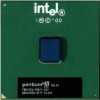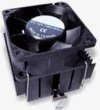Combo 2000: The Search For 1GHz
With Intel overclocking
at it's peak, why actually buy the processor speed you lust after? The efficient
computer purchaser will always consider what the processor of choice can do
when run at its highest speed. To that end, Advanced
Design of Kentucky has created several killer Intel combos. The C2 series
does wonders at up to 165% of their rated speed. How does the current overclocking
king of the P3's do? Not too long ago, I reviewed the slot 1 P3 650 and found
that 866MHz wasn't out of reach. But my thinking was that since Intel has
(on paper) a 1GHz processor, why not go for the gold? Technically, this combo
was rated and sold guaranteed for 980MHz operation. I've just been informed
that AD of K has boosted the mark to 1000MHz, guaranteed. Thanks goes to AD
of K for providing the review sample.
|
Factory
Specifications
|
The
Motherboard
|
- VIA Apollo
133A chipset
- Socket-370
ATX design
- AGP 4X, AGP
½ & PCI ¼ dividers
- 1 AGP, 5 PCI,
0 ISA, 1 CNR slots
- Onboard AC97
audio
- 3 DIMM slots:
1.5GB max
- 4 ATA66 IDE
devices total, 2 USB headers (1 built in)
- Hardware monitoring:
3 temps & 2 fans
|
Iwill VD133PL

Advanced
Design of Kentucky
Combo Price: $640
9/10
Combo Rating
|
|
Factory
Specifications
|
The
Processor
|
- Pentium III
Coppermine Core
- MMX and SSE
support
- 32KB L1 &
256KB L2 Cache
- 1.65 Core Voltage
- 0.18u die,
80°C max temp.
- Socket-370
FC-PGA
- 18.3 Watt Dissipation
|
Intel Pentium !!! Coppermine 700E

|
|
Factory
Specifications
|
The
RAM
|
- 128MB double
sided DIMM
- Infineon 7.5nS
chips
- CAS2 Latency
- Lifetime warranty
|
Techworks
PC133

|
|
Factory
Specifications
|
The
Heatsink & Fan
|
- Rated DC 12V
@ 0.18A
- Dual Ball Bearings
- 4200 RPM fan
speed
- 26 CFM output
- 36 dBA noise
level
- Therm. Cond.
0.0015K
|
GlobalWin FKP-32

|
The Iwill
(make things happen)
The Iwill VD133PL (Pro
Lite) is the very heart and soul of leaving the three digit MHz territory
and entering into previously unattainable four digit land. What extreme overclockers
will want to notice is that no extreme measures were used to touch on such
lofty speed: no peltiers, no 400 watt power supplies, and no additional fans
(case or otherwise). Why, this combo could even save you money!
The Iwill sports the newest
VIA chipset, the 133A. It has all the latest goodies necessary for a high
end system. AGP 4X, PCI ¼ divider, AC97 audio (just kidding), native
ATA66 support, 2 USB headers (you need the kit to have access to the second
set), and socket-370 processor chip support round out the major features.
Thank God, no more adapter cards!
Ports

Not completely jumperless
though as Iwill has chosen to keep the processor core and I/O voltage adjustments
via yellow jumpers. Some in-and-out-of-the-case is necessary until you feel
comfortable with which speed at or above the 1GHz mark you will use long term.
The remaining adjustments,
and there are lots and lots, are accessed through the bye-bye jumper (TM)
Iwill smart setting BIOS (TM). You don't have manual control over the AGP
or PCI dividers, but the predetermined settings were so well placed that I
never thought twice about it. The engineers at Iwill intended overclocking
when the VD133PL was on the drawing board.
 Despite
the best intentions, I did encounter a few problems. The first was the manual.
While I understood the gist of most of the wording, it was obvious that a
non-native English speaker wrote the manual. While I admire Chinese speakers,
they should employ at least 1 native English speaker at all large foreign
companies, especially if they want clear documentation.
Despite
the best intentions, I did encounter a few problems. The first was the manual.
While I understood the gist of most of the wording, it was obvious that a
non-native English speaker wrote the manual. While I admire Chinese speakers,
they should employ at least 1 native English speaker at all large foreign
companies, especially if they want clear documentation.
The second nigggle was
more serious. I tested two BIOS revisions: vpl0313 and vpl0523. These correspond
to dates (i.e. 0313 is March 13th, etc.). Both revisions had only minor differences,
none being higher or lower performance in any appreciable area. (Update)
After tweaking for another day, this is what I've discovered. In order to
activate the advanced memory timing features, you must not use the SDRAM timing
settings of 8nS or 10nS. If these settings are chosen, not only will the host
clock ±33MHz adjustments not function, but the SDRAM cycle length
is rendered useless. This effect is not mentioned in the manual and it is
possible that a BIOS update may change this condition. (End
of update)

